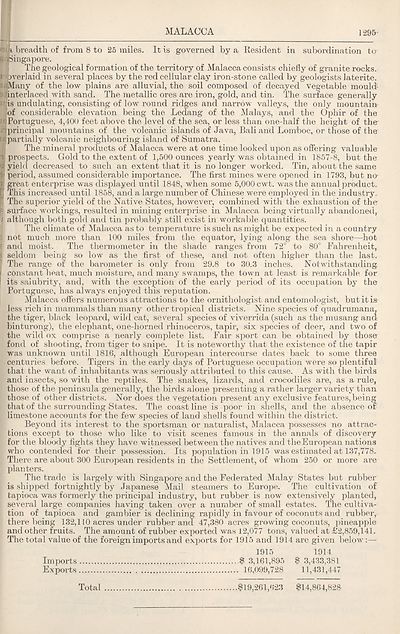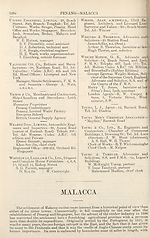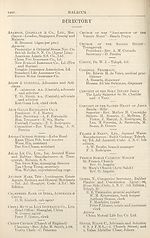1917
(1416) Page 1295
Download files
Complete book:
Individual page:
Thumbnail gallery: Grid view | List view

MALACCA
H i breadth of from 8 to 25 miles. It is governed by a Resident in subordination to
wj Singapore.
The geological formation of the territory of Malacca consists chiefly of granite rocks,
n sverlaid in several places by the red cellular clay iron-stone called by geologists laterite.
wi Many of the low plains are alluvial, the soil composed of decayed vegetable mould-
9ij interlaced with sand. The metallic ores are iron, gold, and tin. The surface generally
w is undulating, consisting of low round ridges and narrow valleys, the only mountain
Bof considerable elevation being the Ledang of the Malays, and the Ophir of the
llPortuguese, 4,400 feet above the level of the sea, or less than one-half the height of the-
iprincipal mountains of the volcanic islands of Java, Bali and Lomboc, or those of the
partially volcanic neighbouring island of Sumatra.
The mineral products of Malacca were at one time looked upon as offering valuable
prospects. Gold to the extent of 1,500 ounces yearly was obtained in 1857-8, but the
yield decreased to such an extent that it is no longer worked. Tin, about the same
period, assumed considerable importance. The first mines were opened in 1793, but no-
great enterprise was displayed until 1848, when some 5,000 cwt. was the annual product.
This increased until 1858, and a large number of Chinese were employed in the industry.
The superior yield of the Native States, however, combined with the exhaustion of the
surface workings, resulted in mining enterprise in Malacca being virtually abandoned,
although both gold and tin probably still exist in workable quantities.
The climate of Malacca as to temperature is such as might be expected in a country
not much more than 100 miles from the equator, lying along the sea shore—hot
and moist. The thermometer in the shade ranges from 72° to 80° Fahrenheit,
seldom being so low as the first of these, and not often higher than the last.
The range of the barometer is only from 29.8 to 30.3 inches. Notwithstanding
constant heat, much moisture, and many swamps, the town at least is remarkable for
its salubrity, and, with the exception of the early period of its occupation by the
Portuguese, has always enjoyed this reputation.
Malacca offers numerous attractions to the ornithologist and entomologist, but it is-
less rich in mammals than many other tropical districts. Nine species of quadrumana,
the tiger, black leopard, wild cat, several species of viverrida (such as the musang and
binturong), the elephant, one-horned rhinoceros, tapir, six species of deer, and two of
the wild ox comprise a nearly complete list. Fair sport can be obtained by those
fond of shooting, from tiger to snipe. It is noteworthy that the existence of the tapir
was unknown until 1816, although European intercourse dates back to some three
centuries before. Tigers in the early days of Portuguese occupation were so plentiful
that the want of inhabitants was seriously attributed to this cause. As with the birds
and insects, so with the reptiles. The snakes, lizards, and crocodiles are, as a rule,
those of the peninsula generally, the birds alone presenting a rather larger variety than
those of other districts. Nor does the vegetation present any exclusive features, being
that of the surrounding States. The coast line is poor in shells, and the absence of
limestone accounts for the few species of land shells found within the district.
Beyond its interest to the sportsman or naturalist, Malacca possesses no attrac¬
tions except to those who like to visit scenes famous in the annals of discovery
for the bloody fights they have witnessed between the natives and the European nations
who contended for their possession. Its population in 1915 was estimated at 137,778,
There are about 300 European residents in the Settlement, of whom 250 or more are
planters.
The trade is largely with Singapore and the Federated Malay States but rubber
is shipped fortnightly by Japanese Mail steamers to Europe. The cultivation of
tapioca was formerly the principal industry, but rubber is now extensively planted,
several large companies having taken over a number of small estates. The cultiva¬
tion of tapioca and gambier is declining rapidly in favour of coconuts and rubber,
there being 132,110 acres under rubber and 47,380 acres growing coconuts, pineapple
and other fruits. The amount of rubber exported was 12,077 tons, valued at £‘2,859,141.
The total value of the foreign imports and exports for 1915 and 1914 are given below
1915 1914
Imports $ 3,161,895 $ 3,433,381
Exports 16,099,728 11,431,447
Total
.$19,261,623 $14,864,828
H i breadth of from 8 to 25 miles. It is governed by a Resident in subordination to
wj Singapore.
The geological formation of the territory of Malacca consists chiefly of granite rocks,
n sverlaid in several places by the red cellular clay iron-stone called by geologists laterite.
wi Many of the low plains are alluvial, the soil composed of decayed vegetable mould-
9ij interlaced with sand. The metallic ores are iron, gold, and tin. The surface generally
w is undulating, consisting of low round ridges and narrow valleys, the only mountain
Bof considerable elevation being the Ledang of the Malays, and the Ophir of the
llPortuguese, 4,400 feet above the level of the sea, or less than one-half the height of the-
iprincipal mountains of the volcanic islands of Java, Bali and Lomboc, or those of the
partially volcanic neighbouring island of Sumatra.
The mineral products of Malacca were at one time looked upon as offering valuable
prospects. Gold to the extent of 1,500 ounces yearly was obtained in 1857-8, but the
yield decreased to such an extent that it is no longer worked. Tin, about the same
period, assumed considerable importance. The first mines were opened in 1793, but no-
great enterprise was displayed until 1848, when some 5,000 cwt. was the annual product.
This increased until 1858, and a large number of Chinese were employed in the industry.
The superior yield of the Native States, however, combined with the exhaustion of the
surface workings, resulted in mining enterprise in Malacca being virtually abandoned,
although both gold and tin probably still exist in workable quantities.
The climate of Malacca as to temperature is such as might be expected in a country
not much more than 100 miles from the equator, lying along the sea shore—hot
and moist. The thermometer in the shade ranges from 72° to 80° Fahrenheit,
seldom being so low as the first of these, and not often higher than the last.
The range of the barometer is only from 29.8 to 30.3 inches. Notwithstanding
constant heat, much moisture, and many swamps, the town at least is remarkable for
its salubrity, and, with the exception of the early period of its occupation by the
Portuguese, has always enjoyed this reputation.
Malacca offers numerous attractions to the ornithologist and entomologist, but it is-
less rich in mammals than many other tropical districts. Nine species of quadrumana,
the tiger, black leopard, wild cat, several species of viverrida (such as the musang and
binturong), the elephant, one-horned rhinoceros, tapir, six species of deer, and two of
the wild ox comprise a nearly complete list. Fair sport can be obtained by those
fond of shooting, from tiger to snipe. It is noteworthy that the existence of the tapir
was unknown until 1816, although European intercourse dates back to some three
centuries before. Tigers in the early days of Portuguese occupation were so plentiful
that the want of inhabitants was seriously attributed to this cause. As with the birds
and insects, so with the reptiles. The snakes, lizards, and crocodiles are, as a rule,
those of the peninsula generally, the birds alone presenting a rather larger variety than
those of other districts. Nor does the vegetation present any exclusive features, being
that of the surrounding States. The coast line is poor in shells, and the absence of
limestone accounts for the few species of land shells found within the district.
Beyond its interest to the sportsman or naturalist, Malacca possesses no attrac¬
tions except to those who like to visit scenes famous in the annals of discovery
for the bloody fights they have witnessed between the natives and the European nations
who contended for their possession. Its population in 1915 was estimated at 137,778,
There are about 300 European residents in the Settlement, of whom 250 or more are
planters.
The trade is largely with Singapore and the Federated Malay States but rubber
is shipped fortnightly by Japanese Mail steamers to Europe. The cultivation of
tapioca was formerly the principal industry, but rubber is now extensively planted,
several large companies having taken over a number of small estates. The cultiva¬
tion of tapioca and gambier is declining rapidly in favour of coconuts and rubber,
there being 132,110 acres under rubber and 47,380 acres growing coconuts, pineapple
and other fruits. The amount of rubber exported was 12,077 tons, valued at £‘2,859,141.
The total value of the foreign imports and exports for 1915 and 1914 are given below
1915 1914
Imports $ 3,161,895 $ 3,433,381
Exports 16,099,728 11,431,447
Total
.$19,261,623 $14,864,828
Set display mode to:
![]() Universal Viewer |
Universal Viewer | ![]() Mirador |
Large image | Transcription
Mirador |
Large image | Transcription
Images and transcriptions on this page, including medium image downloads, may be used under the Creative Commons Attribution 4.0 International Licence unless otherwise stated. ![]()
| Asian directories and chronicles > 1917 > (1416) Page 1295 |
|---|
| Permanent URL | https://digital.nls.uk/194550716 |
|---|
| Attribution and copyright: |
|
|---|---|
| Description | Volumes from the Asian 'Directory and Chronicle' series covering 1917-1941, but missing 1919 and 1923. Compiled annually from a multiplicity of local sources and research. They provide listings of each country's active corporations, foreign residents and government agencies of all nationalities for that year, together with their addresses. Content includes: various treaties; coverage of conflicts; currencies and taxes; consular fees; weights and measures; public holidays; festivals and traditions. A source of information for both Western states and communities of foreigners living in Asia. Published by Hongkong Daily Press. |
|---|---|
| Shelfmark | H3.86.1303 |
| Additional NLS resources: |

